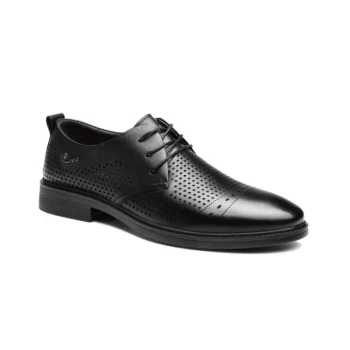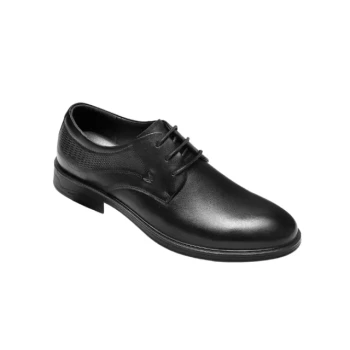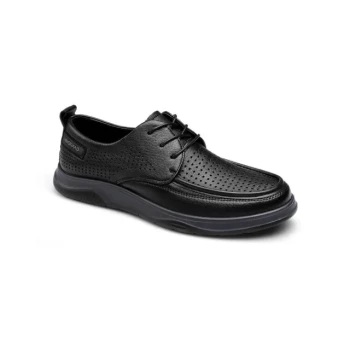In short, leather quality is paramount because the entire value proposition of a Goodyear welted shoe—its durability and ability to be resoled—hinges on the upper outlasting the sole. The construction process itself demands strong leather that won't tear when stitched to the welt, but the true reason is long-term viability. Using inferior leather on a Goodyear welted shoe is like building a house with a revolutionary, replaceable foundation but walls that crumble after a few years.
The core principle of a Goodyear welt is to create a shoe where the upper can outlive multiple soles. High-quality leather is not just a feature; it is the essential material that makes this principle a reality, justifying the shoe's construction and cost.
The Foundation: Why Construction Demands Quality
A Goodyear welt involves a complex stitching process that places unique stress on the upper material. This initial stage of manufacturing is the first test of the leather's integrity.
Withstanding the Stitching Process
The shoe's upper is stitched to a strip of leather called the welt, which is then stitched to the outsole. This requires stitching very close to the edge of the upper.
Inferior, weaker leather would simply tear or break along this seam under the tension of the stitching and subsequent wear, causing the shoe to fail. Only high-quality, durable hides can withstand this process.
Providing a Stable Structure
The leather upper acts as the chassis for the entire shoe. All other components—the insole, the welt, the cork filling, and the outsole—are built around it.
This upper must maintain its shape and integrity for years to provide a stable foundation for future resoles.
The Core Principle: An Upper Built to Outlast the Sole
The ability to resole a shoe is its most celebrated feature, but this feature is only valuable if the rest of the shoe is worth saving. This is where leather quality becomes the deciding factor.
The Logic of Resoling
The primary benefit of a Goodyear welt is that a cobbler can easily remove the old sole and stitch on a new one without compromising the shoe's structure.
This process is only worthwhile if the leather uppers remain in excellent condition. If the leather cracks, tears, or deteriorates, the ability to resole the shoe becomes a moot point.
Aging Gracefully vs. Breaking Down
High-quality leathers, like full-grain calfskin, are chosen because they improve with age. With proper care, they develop a rich patina and become more supple over time.
Lower-grade leathers often have a synthetic coating that cracks and peels, revealing the weaker material underneath. They do not age well and are not intended for a multi-decade lifespan.
Enhancing Comfort Over Time
Goodyear welted shoes are known for their comfort after a break-in period. A layer of cork filler between the insole and outsole gradually molds to the shape of your foot.
A high-quality leather upper complements this by softening and shaping to your foot's unique contours, working in tandem with the cork to create a personalized, comfortable fit.
Understanding the Trade-offs
While superior, the combination of high-quality leather and Goodyear welt construction is not without its considerations. It's a specific approach to footwear with clear trade-offs.
The Upfront Investment
The primary drawback is cost. Selecting, cutting, and stitching premium hides is a labor-intensive process performed by skilled artisans, and the raw materials are expensive. This is reflected in the shoe's initial price.
The Break-in Period
Unlike a sneaker, a well-made Goodyear welted shoe is initially stiff. The thick leather of the upper, the leather insole, and the cork filler all require time and wear to soften and conform to your foot.
The Necessity of Care
Premium leather is not invincible. To realize its potential for longevity, it must be cared for. This means regular cleaning, conditioning, and storing with shoe trees to maintain its shape and moisture balance. Neglecting care will shorten the upper's life significantly.
Making the Right Choice for Your Goal
The importance of leather quality is directly tied to your expectations for the footwear.
- If your primary focus is maximum longevity and long-term value: Prioritize shoes made with full-grain leather, as it provides the most durable foundation for multiple resoles.
- If your primary focus is water resistance and durability: The combination of a strong leather upper and the welt construction creates a robust barrier against the elements.
- If your primary focus is a personalized, supportive fit: Be prepared for a break-in period, knowing that quality leather and a cork bed will result in superior long-term comfort.
Ultimately, in a Goodyear welted shoe, the quality of the leather determines whether you've purchased a disposable item or a lasting investment.
Summary Table:
| Aspect | High-Quality Leather Impact |
|---|---|
| Durability | Withstands stitching stress and long-term wear, preventing tears. |
| Resoling Value | Upper outlasts soles, making resoling worthwhile. |
| Comfort | Molds to your foot over time for a personalized fit. |
| Aging | Develops a rich patina; improves with proper care. |
As a large-scale manufacturer, 3515 produces a comprehensive range of footwear for distributors, brand owners, and bulk clients. Our production capabilities encompass all types of shoes and boots, including premium Goodyear welted footwear crafted with high-quality leathers for unmatched durability and long-term value. Ensure your products meet the highest standards—contact us today to discuss your manufacturing needs!
Related Products
- Custom Manufactured Air Cushion Leather Business Shoes for Wholesale
- Factory Direct Wholesale Leather Comfort Shoes with Dial Closure
- Wholesale Breathable Training Shoes Custom Athletic Footwear Manufacturer
- Wholesale Comfort Leather Business Shoes with Dial Lacing System
- Durable Rubber-Soled Utility Shoes for Wholesale & Custom Brand Manufacturing
People Also Ask
- What should be considered when choosing sneakers for a business casual office look? Achieve Comfort & Professionalism
- Are sneakers appropriate for business casual settings? A Guide to Modern Office Footwear
- Are sneakers acceptable in a business casual workplace? How to Choose the Right Style
- Can sneakers be part of a business casual wardrobe? Yes, with the right style and fit
- Can trainers/sneakers be worn in a business casual setting? How to Choose the Right Style for a Professional Look



















